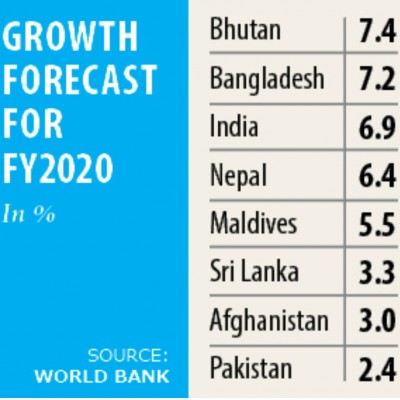Bangladesh second in South Asia in GDP growth: WB

The Bangladesh economy is forecast to achieve the second highest growth rate this fiscal year in South Asia, the World Bank said in its biennial regional economic update yesterday.
Bangladesh’s gross domestic product is projected to grow at 7.2 percent this fiscal year and 7.3 percent the following year, according to the latest edition of the ‘South Asia Economic Focus, Making (De)centralisation Work’,.
Bhutan topped the list with an estimated 7.4 percent growth this fiscal year.
“The outlook is clouded by rising financial sector vulnerability, but the economy is likely to maintain growth above 7 percent, supported by a robust macroeconomic framework, political stability and strong public investments.”
The WB forecast is much lower than the government’s target of 8.2 percent for the current fiscal year.
The GDP is estimated to have grown 8.1 percent in the fiscal year that ended in June, in the highest expansion in the region.
The fiscal year ends in June in Bangladesh, Bhutan, Nepal and Pakistan, and for India it is in March.
Bangladesh will also clock the highest growth in fiscal 2020-21 too, according to the report.
In India, after the broad-based deceleration in the first quarter of the fiscal year, growth is projected to fall to 6 percent come March next year.
Growth is then expected to gradually recover to 6.9 percent in fiscal 2020-21 and to 7.2 percent in the following year.
Pakistan’s growth is projected to deteriorate further to 2.4 percent this fiscal year. In Sri Lanka, growth is expected to soften to 2.7 percent in 2019.
In the Maldives, growth is expected to reach 5.2 percent in 2019 while it is projected to average 6.5 percent in Nepal over this and the next fiscal year. Afghanistan is expected to recover and reach 3 percent in 2020 and 3.5 percent in 2021.
In line with a global downward trend, growth in South Asia is projected to slow to 5.9 percent in 2019, down 1.1 percentage points from April 2019 estimates, casting uncertainty about a rebound in the short term.
The report finds that strong domestic demand, which propped high growth in the past, has weakened, driving a slowdown across the region.
“Declining industrial production and imports, as well as tensions in the financial markets reveal a sharp economic slowdown in South Asia,” said Hartwig Schafer, vice-president of the World Bank for South Asia, in a statement.
As global and domestic uncertainties cloud the region’s economic outlook, South Asian countries should pursue stimulating economic policies to boost private consumption and beef up investments, he added.
In a focus section, the report highlights how—as their economies become more sophisticated—South Asian countries have made decentralisation a priority to improve the delivery of public services.
With multiple initiatives underway across the region to shift more political and fiscal responsibilities to local governments, the report warns, however, that decentralisation efforts in South Asia have so far yielded mixed results. For decentralisation to work, central authorities should wield incentives and exercise quality control to encourage innovation and accountability at the local level.
Rather than a mere reshuffling of power, the report calls for more complementary roles across tiers of government, in which national authorities remain proactive in empowering local governments for better service delivery.
Decentralisation in South Asia has yet to deliver on its promises and, if not properly managed, can degenerate into fragmentation, said Hans Timmer, chief economist of the WB for South Asia.
“To make decentralisation work for their citizens, we encourage South Asian central governments to allocate their resources judiciously, create incentives to help local communities compete in integrated markets and provide equal opportunities to their people.”
